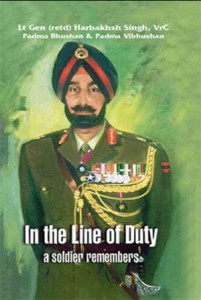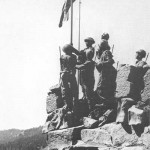 I ordered him, through his Divisional Commander, to be prepared for a counter-attack with reserve companies, should the Pakistanis attack and succeed in overcoming his forward defences. Both the attack and the counter-attack happened, and by 12 noon the situation was restored. In the meanwhile, a message came from 39 Medium Battery of Artillery (this was part of a Sikh Battalion converted into a Medium Artillery Regiment and the message was meant for me as Colonel of the Sikh Regiment) that the personnel of the 161 Artillery Regiment, deployed next to them, had deserted enmass, leaving their guns, with stacked ammunition, and wagon-line (vehicles) behind.They wanted them collected, lest they fall into enemy hands. Despite the desertion, they averred that the Medium Battery, in position, would continue to support the forward Brigade. Upon receipt of this message, I ordered the Divisional Commander, Major General Chopra, in the presence of his Corps Commander, to muster as much manpower and as many electrical mechanical engineers from his Division, as he could, and arrange to collect the guns, the ammunition and the vehicles. Having done so, he could then order 41 Mountain Brigade to withdraw that night. The orders for withdrawal were to get to the Brigade by 2 o’clock that afternoon, so that the Brigade Commander could plan his withdrawal properly. Thereafter, General Kashmir Katoch arid I left Akhnoor, by the same helicopter in which we had come, and flew back to our respective Headquarters.
I ordered him, through his Divisional Commander, to be prepared for a counter-attack with reserve companies, should the Pakistanis attack and succeed in overcoming his forward defences. Both the attack and the counter-attack happened, and by 12 noon the situation was restored. In the meanwhile, a message came from 39 Medium Battery of Artillery (this was part of a Sikh Battalion converted into a Medium Artillery Regiment and the message was meant for me as Colonel of the Sikh Regiment) that the personnel of the 161 Artillery Regiment, deployed next to them, had deserted enmass, leaving their guns, with stacked ammunition, and wagon-line (vehicles) behind.They wanted them collected, lest they fall into enemy hands. Despite the desertion, they averred that the Medium Battery, in position, would continue to support the forward Brigade. Upon receipt of this message, I ordered the Divisional Commander, Major General Chopra, in the presence of his Corps Commander, to muster as much manpower and as many electrical mechanical engineers from his Division, as he could, and arrange to collect the guns, the ammunition and the vehicles. Having done so, he could then order 41 Mountain Brigade to withdraw that night. The orders for withdrawal were to get to the Brigade by 2 o’clock that afternoon, so that the Brigade Commander could plan his withdrawal properly. Thereafter, General Kashmir Katoch arid I left Akhnoor, by the same helicopter in which we had come, and flew back to our respective Headquarters.
The next morning, the 5th of September, my Chief of Staff was rung up by General Officer Commanding 10 Division to say that the Brigade had come back safely, with all its equipment and ammunition. But before congratulating the General Officer Commanding for this successful operation, I asked my Chief of Staff to check up from the General Officer Commanding if the guns had also been brought back. His reply that they could not be brought back made me furious. I ordered his Corps Commander to hold a Court of Inquiry for this lapse. As a result of this inquiry, General Chopra was sacked from his appointment.
It would have been difficult for me to explain why I had fallen sick at that time. People would have indulged in all kinds of speculations.
By attacking across the international border of the Punjab, we had definitely achieved complete surprise on all fronts. Our plan of attack was quite simple. The idea was to advance up to the Ichhogil Canal (which had been built by Pakistan for the defence of Lahore), on a wide front of four axes and to capture the Canal from Ranian, in the North, Dograi on the GT Axis, Barki, on the Khalra Axis, and its termination opposite Ferozepore and turn it into a defence-line against Pakistan and thus save our troops for further operations. My idea was to keep the additional force, including the 1st Armoured Division, in the reserve for the first phase of the operations. And when the Ichhogil Canal was secured, to launch this force, including the Armoured Division, against Sialkot, crossing the river Ravi in the area of Nainakot, an area already in our hands.
For this purpose, we had carried out an engineering reconnaissance of both banks of the river. We could even, in our own time, put up a temporary bridge over the Ravi, since the river was in Indian Territory. But the Chief of the Army Staff had other plans, of which I had no idea. Unknown to me, he had formed another Corps, under the command of his favourite, PN Dunn (whom he promoted out of turn), and had launched it from the direction of Samba, leaving me in the Punjab without any reserves during my offensive towards the Ichhogil Canal! It was bad planning, but there was little I could do for it would have meant going against the wishes of the Chief.
However, the surprise on the Punjab fronts was so complete that we had almost free-sailing until 10 am of the 6th of September, the day of the attack. After 10 am, the Pakistani Mass-Artillery, which was till then sojourning in the Lahore Cantonment, was hurriedly deployed in a pre-prepared position, just behind the Resin Factory, on the GT road, towards Lahore on the Ichhogil Canal. They fired their first salvo against 1 Jat, which had just that morning secured the bridge at Bhaini Dhilwan (near Ichhogil Utter) in the Ranian Sector. The truth is that after the capture of the objective, having faced no opposition, the Jats became lax and sent for their Mess truck and started having their breakfast in the open.
By attacking across the international border of the Punjab, we had definitely achieved complete surprise on all fronts.
The Pakistan Mass-Artillery hit the area where the officers were having their breakfast and the Battalion, consequently, scattered running helter-skelter! There is an object lesson in this: that before a war, the officers and Other Ranks must be put through ‘Battle Innoculation’ and should be generally oriented to battlefield conditions, however easy the victory might be. As a consequence of this, it took two more attacks, by different battalions, and heavy casualties, before the objective, the bridge over the Ichhogil Canal, could be, regained.
The Mass-Artillery of the enemy, then took on Dera Baba Nanak and caused a break-through over the bridge, by arm our and some infantry; and later still, concentrated its fire power against 15 Infantry Division position on the GT Axis. But, until mid-day of the 6th of September, all that was opposing 15 Infantry Division on the GT Axis, was just a company of the enemy’s Reconnaissance and Support Battalion, which had been sent ahead to oppose the Indian Offensive. This Reconnaissance and Support Battalion had been introduced into the Pakistan Army by the Americans, at the scale of one per Corps. It was fully mounted on jeeps, armed with formidable firepower: 12 Recoilless guns and 12 Medium Machine Guns per Company. A Company came up to the Canal and started firing aimlessly and this is what made Niranjan Prasad believe that he was being counterattacked by ‘two Divisions’, as conveyed in his message.





nirajan prasad, bm kaul, kishanpal, gen thapar, there are plenty in our senior echelons who should have faced a firing squad. but alas for the faith of the public to be not shaken in the last argument of the indian state our armed forces people like these get away.
Niranjan Prasad was a coward who abandoned his position and a disgrace to our Army.